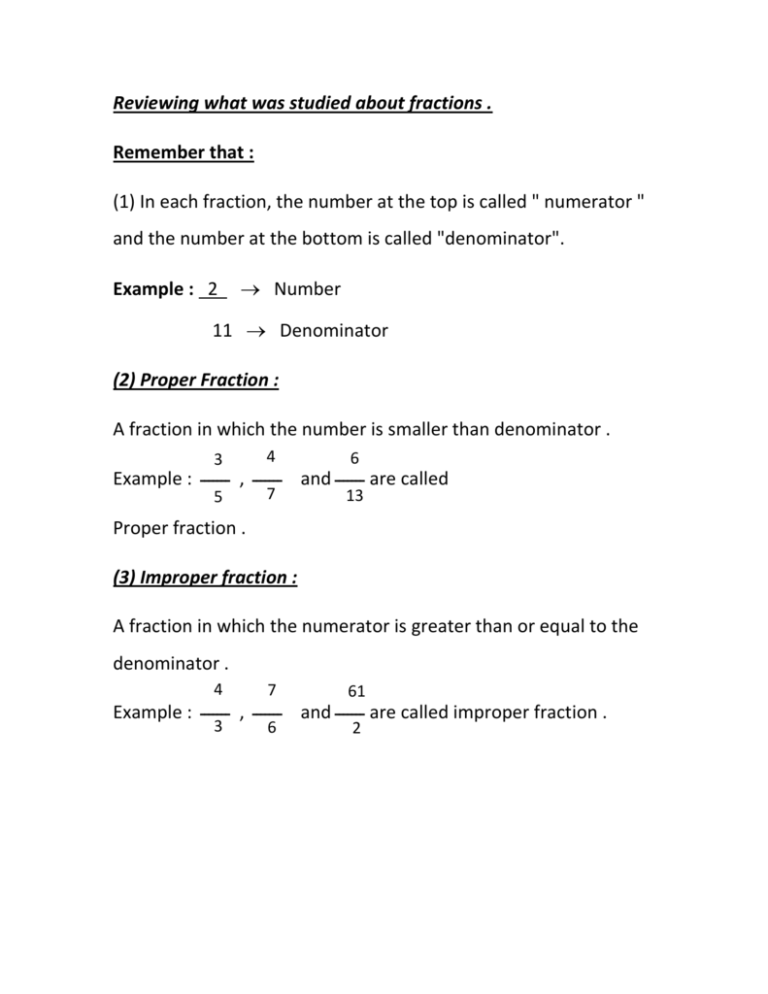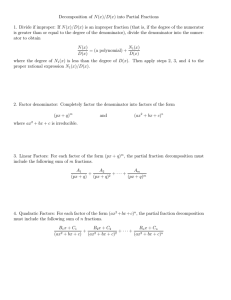Reviewing what was studied about fractions . Remember that : (1) In
advertisement

Reviewing what was studied about fractions . Remember that : (1) In each fraction, the number at the top is called " numerator " and the number at the bottom is called "denominator". Example : 2 Number 11 Denominator (2) Proper Fraction : A fraction in which the number is smaller than denominator . 3 4 5 7 6 Example : ـــــــ, ـــــــand ـــــــare called 13 Proper fraction . (3) Improper fraction : A fraction in which the numerator is greater than or equal to the denominator . 4 7 61 Example : ـــــــ, ـــــــand ـــــــare called improper fraction . 3 6 2 (4) Equivalent Fractions : To find equivalent fractions, multiply or divide both of the numerator and denominator by the same number . ( other than Zero). x2 2 4 Example : = ـــــــ ـــــــ 5 10 x2 (5) Simplifying the fraction : To reduce ( simplify) a fraction to its simplest form , we divide each of the numerator and the denominator by the greatest possible common number : ÷4 4 Example : ـــــــ 1 = 12 4= 2x2 12 = 2 x 2 x 3 H.C.F = 2 x 2 =4 ÷4 ـــــــ 3 (6) Adding fractions : When you are adding some fractions of the same denominator, add the numerators and use the same denominator . 3 Example : ـــــــ+ = ـــــــ 7 5 2 7 ـــــــ 7 (7) Subtracting fractions : When you are subtracting two fractions of the same denominator , subtract the numerators and use the same denominator. 3 2 1 Example : ـــــــ- ـــــــ = ـــــــ 7 7 7 ============================================== Exercise 1: 1- Write each of the following whole numbers as an improper fraction : (a) 6 = (c) 10 = …. 1 …. 3 .…. (b) 16 = 2 12 (d) 4 = …. Units of measuring length *The meter(m) = 100 centimeters (cm) * 1 meter(m) = 10 decimeter(dm) * 1centimetres(cm) = 10 decimeter(dm) * The centimeters(cm) = 10 millimeters(mm) * The kilometer(km) = 1000 meters(m) * Perimeter of a square = side length 4 * perimeter of a rectangle = ( length + width ) 2 1000 10 10 10 km m. Dm. Cm. mm. ÷1000 ÷10 ÷10 ÷10 Examples 3 m. = 300cm. 3.5m. = 350cm. 6.5cm = 65cm. 5dm. = 50cm. 15dm. = 15cm. = 150mm. , , , , , 4m. = 400cm. 3 cm. = 30mm. 4m.= 400cm.= 4000mm. 3dm. = 30cm. = 300mm. 8km. = 800m. = 80dm. Note: *The perimeter of polygon equals the sum of it’s side lengths. 4cm.3 cm 5cm. 5 cm 3cm the perimeter of =3cm. +4cm. +5cm=12cm The Area * The area of square = side length itself * The area of rectangle = length width *Notes : m² = 1m 1m = 100cm 100 cm = 10000cm² dm² = 1dm 1dm = 10cm 10cm = 100cm² km² = 1km 1km = 1000m 1000m = 1000 000 m² 1000 000 100 100 𝒌𝒎𝟐 𝒎𝟐 . 𝑫𝒎𝟐 . ÷ 1 000 000 ÷ 100 100 𝑪𝒎.𝟐 ÷100 𝒎𝒎𝟐 ÷100 The Time X7 Week X 24 Day ÷𝟕 X 60 Hour ÷ 24 X 60 Minute ÷ 60 second ÷ 60 Remember that :Even numbers :- (0 , 2 , 4 , 6 , 8 , 10 , …………..) Odd numbers :- (1 , 3 , 5 , 7 , 9 , 11 , ………….. ) Prime number :- number has only two factors one and itself (2 , 3 , 5 , 7 , 11 , 13 , …………..) Notes : * The prime number is divisible only by 1 and itself. * 2 is the smallest Prime number. * 2 is only even prime number. * All prime numbers are odd except 2. * 1 is not a prime number because it has only one factor. * find H.C.F and L.C.M for 24 , 18 24 2 18 2 24= 2X2X2X3 12 2 9 18= 2X 6 2 3 3 H.C.F=2X3 =6 3 3 1 L.C.M=2X2X2X3X3=72 1 3 3X3








